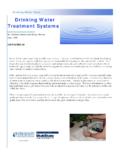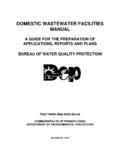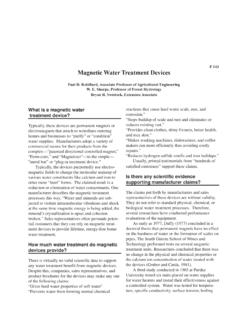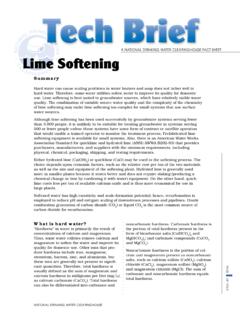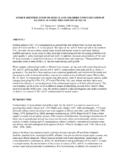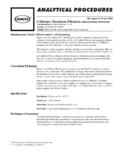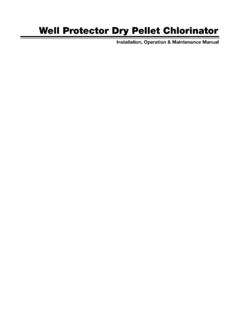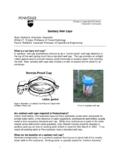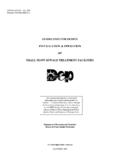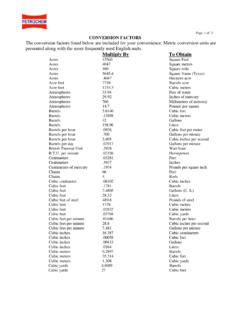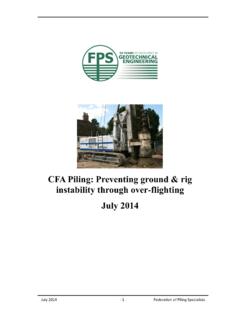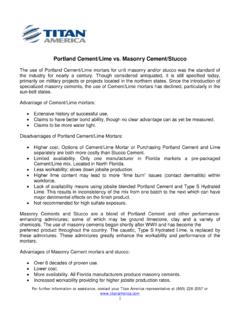Transcription of How does UV work? - Water Research Center
1 Ultraviolet Disinfection 1 Ultraviolet (UV) sanitizing units are used in many Water purification systems to control bacteria and havecertain applications in animal drinking Water systems. UV units can be effective Water treatment tools, butit is important to recognize what UV can do, what its limitations are, and what maintenance is you have any further questions or concerns about UV disinfection or drinking Water quality, contactEdstrom Industries at 800-558-5913 or e-mail: does UV work ?Ultraviolet or UV energy is found in the electromagnetic spectrum between visible light and x-rays andcan best be described as invisible radiation. In order to kill microorganisms, the UV rays must actuallystrike the cell.
2 UV energy penetrates the outer cell membrane, passes through the cell body and disruptsits DNA preventing reproduction. UV treatment does not alter Water chemically; nothing is being addedexcept energy. The sterilized microorganisms are not removed from the Water . UV disinfection does notremove dissolved organics, inorganics or particles in the degree of inactivation by ultraviolet radiation is directly related to the UV dose applied to the dosage, a product of UV light intensity and exposure time, is measured in microwatt second persquare centimeter ( ws/cm2 ). The accompanying table lists dosage requirements to destroy commonmicroorganisms. Most UV units are designed to provide a dosage greater than 30,000 ws/cm2 after oneyear of continuous operation.
3 Notice that UV does not effectively disinfect some organisms (most molds,protozoa, and cysts of Giardia lamblia and Cryptosporidium) since they require a higher units for Water treatmentSpecial low-pressure mercury vapor lamps produce ultraviolet radiation at 254 nm, the optimalwavelength for disinfection and ozone destruction. The UV lamp never contacts the Water ; it is eitherhoused in a quartz glass sleeve inside the Water chamber or mounted external to the Water which flowsthrough UV transparent Teflon tubes. Some ultrapure Water systems use 185 nm UV units for reducingTOC (total organic carbon).Important variables for successful disinfectionAlthough 100% destruction of microorganisms cannot be guaranteed, it is possible to achieve in certain applications and with proper maintenance.
4 In order for a UV unit to successfullydisinfect Water , the following variables must be considered: Water QualityCertain contaminants in Water can reduce the transmission of UV light through the Water , whichreduces the UV dose that reaches the bacteria. These UV absorbing contaminants includeturbidity, iron, and humic and fulvic acid, common to surface Water supplies. Suspended particlesare a problem because microorganisms buried within particles are shielded from the UV light andpass through the unit unaffected. UV disinfection is most effective for treating high-claritypurified reverse osmosis or distilled Ultraviolet DisinfectionRecommended Maximum ConcentrationLevels for Water to be Treated By UVTurbiditySuspended SolidsColorIr onManganesepHHardness5 NTU10 < 6 grainsFlowrateAll UV units have a maximum flowrate capacity and some have a minimum flowrate as well.
5 Ifthe flow is too high, Water will pass through without enough UV exposure. If the flow is too low,heat may build up which can damage the UV lamp. The Water flow in an animal drinking watersystem is usually low and intermittent so a UV unit with minimum flow requirements should notbe placed on the Water line supplying pressure stations in a non-recirculating system. UV unitsare most often used in constant flow recirculating Dosage RequiredFor Destruction of Various Organisms( W-s/cm2 at 254 nanometer)BacteriaMold SporesBacillus anthracis8,700 Aspergillus flavus99,000B. enteritidis7,600 Aspergillus glaucus88,000B. Megatherium sp. (vegatative)2,500 Aspergillus niger330,000B.
6 Megatherium sp. (spores)52,000 Mucor racemosus A35,200B. paratyphosus6,100 Mucor racemosus B35,200B. subtilis (vegatative)11,000 Oospora lactis11,000B. subtilis (spores)58,000 Penicillium digitatum88,000 Clostridium tetani22,000 Penicillium expansum22,000 Corynebacterium diphtheria6,500 Penicillium roqueforti26,400 Eberthella typhosa4,100 Rhizopus nigricans220,000 Escherichia coli7,000 Leptospira interrogans6,000 Micrococcus candidus12,300 Algae / ProtozoaMicrococcus sphaeroides15,400 Chlorella vulgaris (algae)22,000 Mycobacterium tuberculosis10,000 Nematode eggs92,000 Neisseria catarrhalis8,500 Paramecium200,000 Phytomonas tumefaciens8,500 Proteus vulgaris6,600 Pseudomonas aeruginosa10,500 VirusPseudomonas fluorescens6,600 Bacteriophage (E.)
7 Coli)6,600 Salmonella enteritidis7,600 Hepatitis virus8,000 Salmonella paratyphi6,100 Influenza virus6,600 Salmonella typhimurium15,200 Polio virus6,000 Salmonella typhosa (Typhoid)6,000 Rotavirus24,000 Sarcina lutea26,400 Tobacco mosaic440,000 Serratia marcescens6,200 Shigella dysenteriae (Dysentery)4,200 Shigella paradysenteriae3,400 Spirillum rubrum6,160 YeastStaphylococcus albus5,720 Baker s yeast8,800 Staphylococcus aureus6,600 Brewer s yeast6,600 Streptococcus hemolyticus5,500 Common yeast cake13,200 Streptococcus lactis8,800 Saccharomyces cerevisiae13,200 Streptococcus viridans3,800 Saccharomyces ellipsoideus13,200 Vibrio cholerae6,500 Saccharomyces ,600 Ultraviolet Disinfection 3 Limitations of UV treatmentUnder ideal conditions, a UV unit can provide greater than 99% reduction of all bacteria.
8 Even with thisperformance, ultraviolet disinfection has the following limitations: Point DisinfectionUV units only kill bacteria at one point in a watering system and do not provide any residualgermicidal effect downstream. If just one bacterium passes through unharmed (100% destructionof bacteria cannot be guaranteed), there is nothing to prevent it from attaching to downstreampiping surfaces and Not RemovedBacteria cells are not removed in a UV unit but are converted into pyrogens. The killedmicroorganisms and any other contaminants in the Water are a food source for any bacteria thatdo survive downstream of the UV to these limitations, the piping in a watering system treated by UV disinfection will need to beperiodically sanitized with a chemical requirements for UV unitsLamp ReplacementUV lamps do not burn out as normal florescent lamps do.
9 Instead, the UV lamps will solarize,reducing their intensity to about 60% of a new lamp after about one year of continuous use. Whenlamps are new, they will generate a dosage level near 60,000 W-s/cm2. When the dosage dropsto 30,000 W-s/cm2 (the minimum dosage needed to effectively kill bacteria) lamps should bereplaced. Lamp life will be shortened significantly if the lamp is turned on and off morefrequently than once every eight PerformanceWater should be sampled and tested for bacteria counts regularly. Sample before and after the UVunit to test its performance. Water should also be sampled in the animal rooms since bacteriaregrowth can occur downstream of the UV Water passes through the UV unit, minerals, debris and other material in the Water will depositout and onto the quartz or Teflon sleeve.
10 This will limit the penetration of UV rays through thesleeve and into the Water . To maintain high clarity, the glass around the lamp must be cleanedregularly. Cleaning frequency depends on the Water quality and will be minimal with RO,distilled, or deionized UV DosageUV light intensity meters are available which indicate the penetration of UV light through theglass sleeve and the Water . Low intensity means the UV dose is too low to provide adequatedisinfection. This meter will indicate when cleaning or lamp replacement is Recirculation SystemsOne application where ultraviolet disinfection is used is in recirculating delivery systems.
